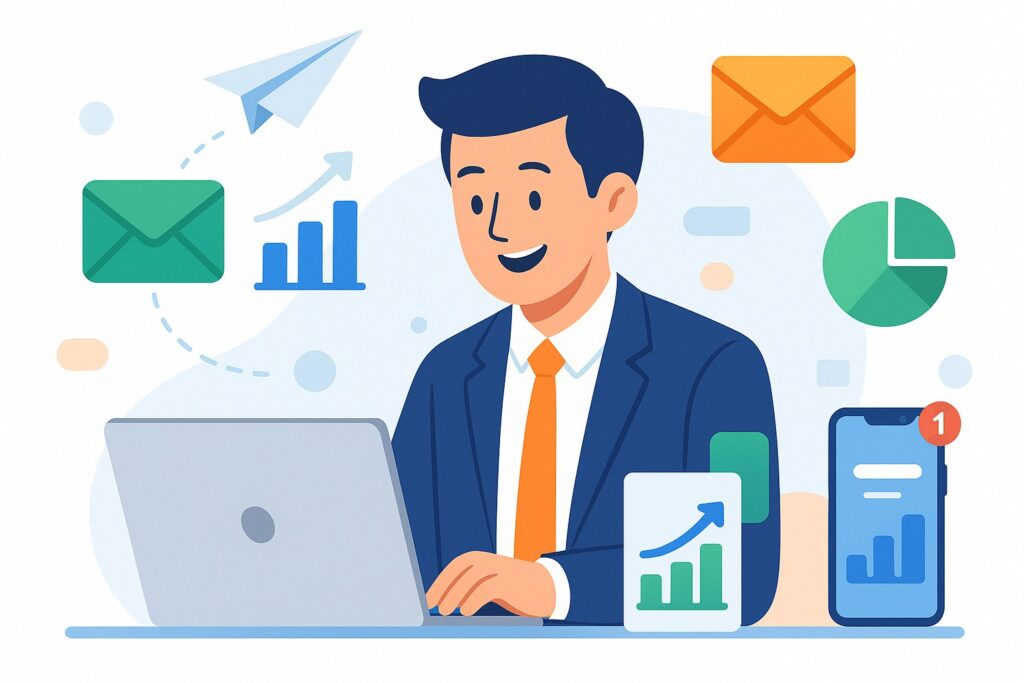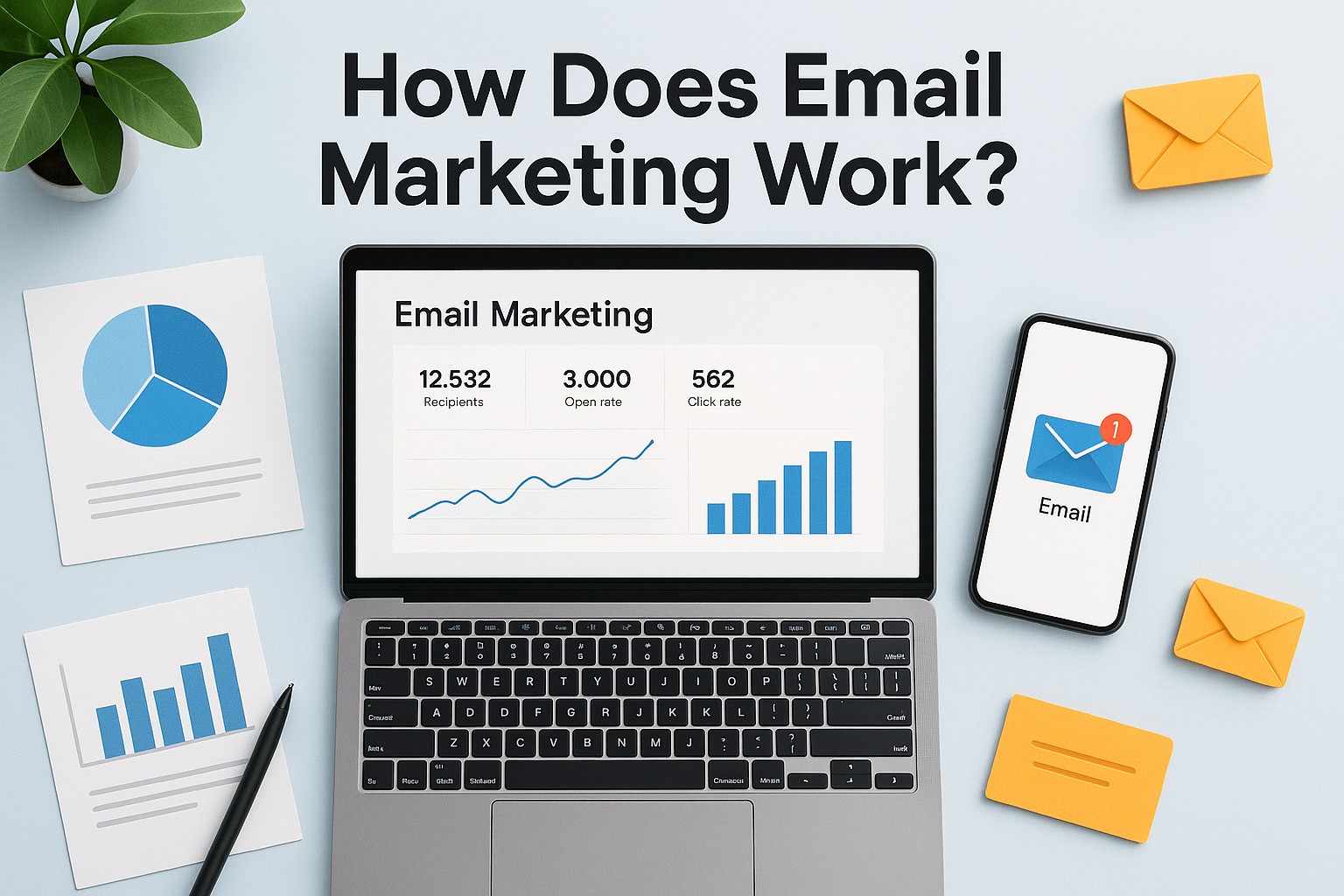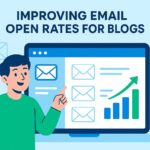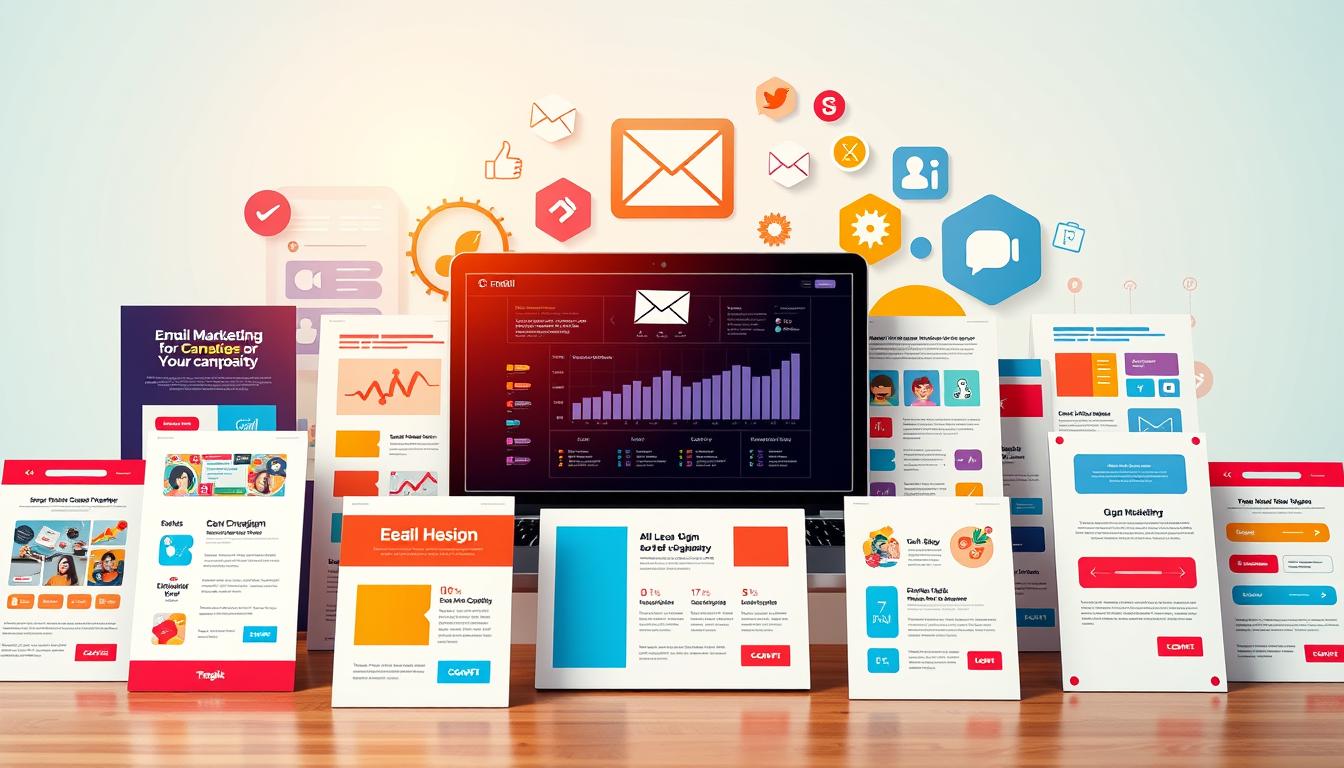I’m excited to walk you through the basics of email marketing and show you how it can help your business grow. We’ll explore its importance in today’s digital world. You’ll learn its core principles and how it helps businesses.
Email marketing lets businesses connect with their audience and build lasting relationships. It helps promote products and drive sales. Once you understand the basics, email marketing becomes a simple yet powerful way to strengthen your strategy and grow your business.
What Is Email Marketing?
Email marketing is the practice of using email to share products, services, and updates with your audience, keeping them informed and engaged. It’s an effective way for businesses to connect with customers and reach new people.
Purpose of Email Marketing
Email marketing means sending personalized messages and special offers directly to your audience’s inbox to engage them effectively. It aims to build relationships, sell more, and make people know about your brand. A study shows it can bring in $42 for every $1 spent, making it very good for marketing.
Understanding email marketing is key. It’s not just sending emails. Email marketing is about connecting with your audience in a real and meaningful way.
Types of Marketing Emails
There are many kinds of marketing emails. These include:
- Promotional emails
- Transactional emails
- Relationship-building emails
Promotional Emails
Promotional emails aim to sell something. They might try to get more people to visit your website or buy something. For example, an online store might send out emails about new products.
Transactional Emails
Transactional emails happen when someone does something, like buying something. They give important info, like order confirmations or shipping updates. These emails help build trust and ensure your customers have a positive experience with your brand.
Relationship-Building Emails
Relationship-building emails help keep people interested. They share useful stuff, like tips or news. For example, a software company might send emails with tips on how to use their product better.
Why Email Marketing Matters for Businesses
Email marketing is key for businesses today. It helps them connect with their audience. It’s important to see how it impacts businesses.
Advantages Over Other Marketing Channels
Email marketing has many benefits. It’s a top choice for businesses. Some of these benefits are:
- Cost-effectiveness
- Direct communication
- Measurability
Cost-Effectiveness
Email marketing is very affordable. It lets businesses talk to many people without spending a lot. This is great for small and medium-sized businesses with tight budgets.
Direct Communication
Email marketing lets businesses talk directly to their audience and keep them informed and interested. This builds a strong bond with customers.
Measurability
Email marketing is easy to measure. Businesses can track the performance of their emails to see what’s working and make improvements.
By using these benefits, businesses can make email marketing a powerful tool to grow and engage their audience.
How Actually Email Marketing Work.
When you send an email, it goes through a few important steps to make sure it gets to the right inbox. From being processed by your email server to passing spam filters and finally appearing in your recipient’s inbox, each step is crucial to ensure your message is delivered successfully. Knowing these steps can make your emails better.
Email Servers and Delivery Systems
Email servers are very important. They send, receive, and keep emails. Your email service provider uses its servers to send your emails to others.
From Send Button to Recipient’s Inbox
When you press send, many things happen. First, your ESP checks if the email is real. Next, the email is sent to the recipient’s server, which checks it for security and spam before delivering it to the inbox.
Authentication Protocols (SPF, DKIM, DMARC)
Authentication protocols keep emails safe. SPF tells who can send emails for a domain. DKIM adds a special code to emails. DMARC stops fake emails.
Inbox Placement Factors
Where an email goes depends on a few things. The sender’s reputation and the content of the email play a big role in whether it reaches the inbox successfully. How people react to the email also plays a big role.
| Inbox Placement Factor | Description | Impact |
|---|---|---|
| Sender Reputation | The reputation of the sender’s IP address and domain. | High |
| Email Content | The content of the email, including text and images. | Medium |
| Recipient Engagement | How recipients interact with the email, such as opens and clicks. | High |
Building Your Email List
A strong, focused email list is key to making your email marketing campaign successful. We’ll look at how to grow your list and make sure it’s full of people who really want to hear from you.
Opt-in Methods and Lead Magnets
Opt-in methods help you build a list that follows the rules and is interested in your emails. Lead magnets are a big part of this.
Single vs. Double Opt-in
You can expand your email list using two methods: single opt-in, where subscribers join instantly, and double opt-in, which adds an extra confirmation step for accuracy and engagement. Single opt-in means someone can subscribe to your email list just by entering their email address. Double opt-in makes them click a link in their email to confirm.
Single opt-in gets you more people, but double opt-in means you have a better list.
Effective Lead Magnet Ideas
Lead magnets are valuable offers, like guides, discounts, or freebies, that encourage people to join your email list. Good ones include:
- Exclusive eBooks or guides that teach something new.
- Discounts or coupons that save money.
- Free trials or demos to try out your product.
These magnets not only get people to join but also start a relationship with them.

Growing Your Subscriber Base Ethically
It’s important to grow your list the right way. This means respecting people’s choices and keeping their info safe.
Permission-Based Marketing
Permission-based marketing is all about getting clear yeses before you send emails. Following the rules is required by law and helps build trust with your readers.
List Hygiene Practices
Keeping your list clean is vital. This means getting rid of bad emails and making it easy for people to change their settings or leave your list.
By doing this, you’ll have a list that’s not only legal but also more likely to care about what you send.
Segmentation and Personalization Strategies
To improve your email campaigns, segment your audience and personalize your messages. Speaking to subscribers in a personal way makes them more engaged and more likely to buy from you.
Dividing Your Audience for Better Results
Segmentation means splitting your email list into smaller groups based on what people like or how they behave. You do this based on certain criteria. It makes your campaigns more effective.
Demographic Segmentation
Demographic segmentation sorts your audience by age, gender, and location. This allows you to make content that really connects with each group.
Behavioral Segmentation
Behavioral segmentation looks at what your subscribers do. For example, you can group people based on what they buy or how they engage with your emails. It lets you target your campaigns better.
Purchase History Segmentation
Segmenting by purchase history lets you send special offers. These are likely to catch their interest.
Personalization Techniques That Drive Engagement
Personalization is more than just using names. The goal is to create content that truly connects with your audience.
Dynamic Content
Dynamic content shows different things to different people in the same email. Your content can change depending on who your audience is and how they behave.
Personalized Recommendations
With data on what your subscribers have bought, you can suggest things they might like. It’s a great way to engage them.
Using segmentation and personalization strategies can really boost your email marketing. This gets more people to interact with your emails and helps turn subscribers into customers.
Creating Effective Email Campaigns
Creating effective email campaigns is essential for online success. To do well, businesses need to focus on a few key elements. These things help people engage and buy from you.
Subject Lines That Get Opens
Your subject line is the first thing people see. So, make it good. Use action-oriented language and personalization to get more opens. Keep it short and avoid spam words.
For example, “Your Exclusive Offer Inside” is better than “Newsletter.”
Crafting Compelling Email Content
After getting someone’s attention, your email needs to keep it. Write clearly and concisely. Make sure your content is interesting to your audience.
Email Design Best Practices
Design your email to look good on all devices. It should be clean and easy to read. Make sure your email is pretty and easy to follow.
Writing for Engagement
Think about what’s good for the reader. Write in a friendly way. Use stories in your emails to make them more engaging and easier for people to remember.
Call-to-Action Best Practices
A clear call-to-action (CTA) is key to getting people to do something. Use words that tell people to act. Make your CTA stand out.
Button Design and Placement
Use a different color for your CTA button. Place it somewhere visible so people notice it immediately. Make sure it’s big enough to click on phones.
Compelling CTA Copy
Use words that encourage people to take action quickly. Say things like “Limited Time Offer” or “Sign Up Now.” Make sure your CTA matches your email and goal.
| Email Campaign Element | Best Practice | Example |
|---|---|---|
| Subject Line | Use action-oriented language and personalization | “Your Exclusive Offer Inside” |
| Email Content | Clear and concise writing style, relevant to audience | Focus on benefits to the reader |
| Call-to-Action | Clear and prominent, action-oriented language | “Sign Up Now” |
Email Marketing Automation and Tools
Email marketing automation makes campaigns better. It lets businesses focus on creating interesting content. This method uses software to send messages to people automatically.
Popular Email Marketing Platforms
Many email marketing platforms exist, each with its own features and prices. Some top ones are Mailchimp, Constant Contact, and Klaviyo.
Free vs. Paid Solutions
Choosing between free and paid email marketing platforms is key. Free ones are good for small businesses or beginners. But, they have limits on subscribers and emails. Paid plans have more features and are better for growing businesses.
Features to Look For
When choosing an email marketing platform, look for features like automation, segmentation, and analytics. Automation lets you send emails automatically based on user actions. Segmentation helps you target specific groups, and analytics shows how your emails are performing so you can improve them.
Setting Up Automated Email Sequences
Automated email sequences help nurture leads and boost conversions. They send emails based on actions, giving a personalized experience.
Welcome Series
A welcome series is a sequence of emails designed to greet new subscribers and introduce them to your brand. It’s a chance to show your brand’s tone and start a relationship.
Abandoned Cart Emails
Abandoned cart emails remind customers about items left in their cart. They can help recover lost sales by encouraging customers to buy.
Re-engagement Campaigns
Re-engagement campaigns reach out to inactive subscribers. They send special offers or content to spark interest and get subscribers active again.
Measuring Email Marketing Success
It’s important to track how well your email marketing is performing. You need to watch important numbers and use tools to get better.
Metrics to Track
There are a few key numbers you should watch closely. These are open rates, click-through rates, how many people do what you want, and how your list grows.
Open and Click-Through Rates
Open rates show how many people opened your email, while click-through rates show how many clicked on a link inside it. These numbers tell you if your email is interesting.
Conversion and Revenue Metrics
Conversion metrics show how many people did what you wanted them to. Revenue metrics tell you how much money your email made. These numbers show if your email is good for business.
List Growth and Unsubscribe Rates
List growth rate shows how fast your email subscriber base is expanding. Unsubscribe rates tell you how many people don’t want to hear from you anymore. Watching these helps you keep your list healthy.
Using Analytics to Improve Performance
Analytics are essential for improving your email marketing results. By looking at your numbers, you can find what needs work and make smart choices.
A/B Testing Fundamentals
A/B testing means sending two versions of an email to find out which performs better. It helps improve subject lines, content, and calls-to-action.
Iterative Improvement Process
The process of getting better never stops. You keep watching your numbers, making changes, and trying new things. This lets you keep improving your email marketing step by step.

Conclusion: Getting Started with Email Marketing
Now you know the basics of email marketing and why it’s important for businesses. It’s time to start. Build a targeted email list, make effective campaigns, and use automation tools. This will help you get more people involved and increase sales.
To start your email marketing, pick a good platform like Mailchimp or Constant Contact. These platforms are easy to use and have great features for managing your campaigns. Make sure your content is high-quality and speaks to your audience. Try different subject lines and calls-to-action to see what works best.
As you get into email marketing, keep an eye on how well your campaigns are doing. Look at open rates and click-through rates. This lets you make your email campaigns better and more effective over time. With time and effort, you’ll get good at email marketing and help your business grow. Starting with email marketing is a great way to increase your online presence.
FAQ
How can you build a strong and engaged email subscriber list?
The best way is through opt-in methods. Use lead magnets and make sure you have permission. You can choose single or double opt-in to verify new subscribers.
How often should I send marketing emails?
How often depends on your audience and content. Find a balance to stay in touch without overwhelming.
What are some effective email marketing automation tools?
Tools like Mailchimp, Constant Contact, and HubSpot are popular. They offer automated sequences, personalization, and analytics to boost your campaigns.
How can I track and measure the effectiveness of my email marketing campaigns?
Monitor metrics like open rates, click-through rates, conversions, and how fast your email list is growing. Use analytics to find ways to get better and adjust your plans.
What is email segmentation and how does it boost campaigns?
Segmentation splits your list into groups based on behavior or demographics, letting you send more personalized emails for higher engagement and better results.
How can I improve my email open rates?
To get more people to open your emails, use catchy subject lines and personalize them. Also, split your list into groups and make sure your emails look great on phones.
How can I write emails that get results?
Keep emails short and clear, include a strong call-to-action, and use personalization and segmentation for relevance.
How do I avoid being marked as spam?
Avoid spam by having a clear unsubscribe link and using a recognizable sender name. Don’t use spammy keywords or too much punctuation in subject lines. Only send to those who have opted-in.










Leave a comment